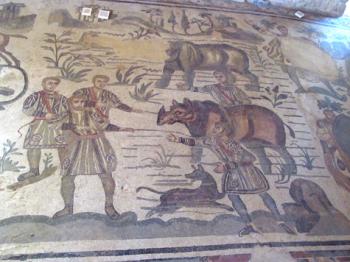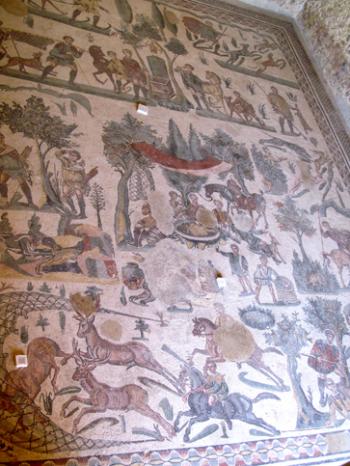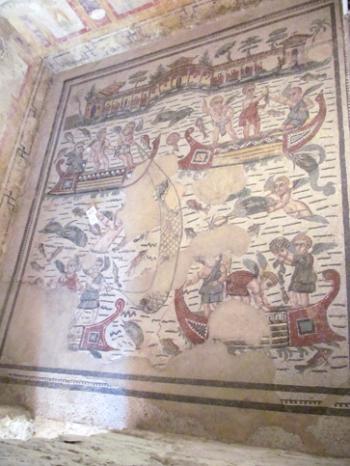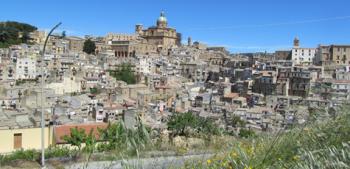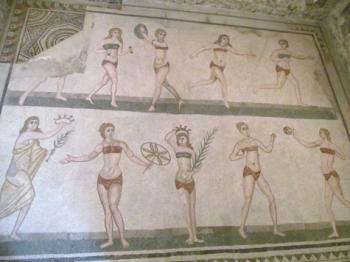Villa Romana del Casale in Sicily
This item appears on page 58 of the April 2017 issue.
Villa Romana del Casale
The Romans weren’t the first to invade, conquer or settle Sicily. Preceding them were tribal groups originally from mainland Italy or other parts of the Mediterranean: the Sicans, Elymians and Sicels.
The Greeks and the Phoenician-Carthaginians followed, both during the eighth century BC. They thrived, built cities, traded, fought each other and were both ultimately defeated by the Romans, who arrived in Sicily in the mid-third century, making it one of their provinces soon thereafter.
With the Romans came temples (many were Greek temples, Romanized), aqueducts, roads and villas. It was one of the Roman villas that my husband, Paul, and I traveled to central Sicily to visit in May 2016. Located just a few miles outside the hill town of Piazza Armerina, Villa Romana del Casale (Roman Villa of Casale) is not just a grand villa, it is arguably the grandest of the grand Roman villas.
Villa Romana del Casale is one of the largest villas surviving from Roman times. It covers 38,000 square feet. (This could be compared to 19 houses each 2,000 square feet, or 19 “average”-size American houses.) There are dozens of rooms located in four interconnected buildings joined by courtyards and corridors.
World-class mosaics
It isn’t just its sheer size that has made Villa Romana del Casale (Paul calls it the McMansion of the Roman era) a UNESCO World Heritage Site. It’s the mosaics that cover the majority of the floors of the villa’s rooms, mosaics that depict hunting and fishing scenes, garden tableaux, mythological stories, even portraits of the family who once called this villa home. To say that these mosaics are fabulous is to say that Mt. Etna is a hill.
Whose home was this? No one knows for sure. Some experts claim a Roman senator built the villa, possibly as a retirement home. Others say it was a wealthy landowner’s mansion, since the villa was once surrounded by large farming estates. But most evidence points to Maximianus Herculius (Maximian), who was co-emperor with Diocletian from AD 286 to 305 and who may have built this as his hunting lodge.
History of the villa
The villa was probably occupied until the middle of the fifth century, after which it was periodically devastated by waves of Vandals, Visigoths and Ostrogoths, then occupied from the sixth to 12th centuries during the Byzantine, Arab and Norman periods of Sicily’s history.
Sometime in the mid-12th century it was buried in a landslide, not to be rediscovered until 1881. The tragedy of the landslide turned out to be the salvation of the mosaics. They lay undisturbed and preserved for more than 700 years.
There are four principal areas comprising the villa: the grand-entrance courtyard; the peristyle surrounding a central garden (with mosaics beneath porticoes) that led to guest and family rooms; an immense triclinium, or dining room, and, finally, extensive baths with amenities (gymnasium, sauna, massage, pools) that would compare well with an upscale, 21st-century spa.
Favorite rooms
A tome could be written about the villa’s mosaics, but I can only mention my four favorite rooms. These I dubbed “the most charming,” “the most beautiful,” “the most famous” and “the most majestic.” (Feel free to disagree; this is a purely personal list. Even Paul and I disagree.)
The Sala degli Amorini Pescatori (Room of the Cherub Fishermen) earns my “most charming” award. It depicts cherubs using lines, nets and fish to trap fish from colorful boats; one cherub swims alongside, teasing a dolphin. On the shore behind is a lovely villa with a colonnade with a variety of trees looming up behind it. To me, this villa looked Asian, as if the mosaic maker might have somehow seen a Chinese scroll.
“Most beautiful” goes to the Sala della Piccola Caccia, or Room of the Small Hunt, where five parallel tiers of mosaics depict hunting scenes. In the middle of one tier, hunters offer a sacrifice, appropriately, to Diana, goddess of the hunt. Just below, a group sits beneath a red canopy banqueting on, presumably, what they’ve caught.
To me, this mosaic floor, which might once have been a guest room or a dining room, resembled rich-looking Persian carpets I’ve seen in Iran.
Bikini girls
There is no argument about the “most famous” room. Unquestionably, it is the Sala delle Dieci Ragazze, or Room of the Ten Girls, where 10 young women (well, maybe nine, since one of the figures is 80% obliterated) engage in sports, including ball playing, discus throwing and running. They wear bikini-like underwear, giving this room the alternate name of Room of the Bikini Girls. It seems that most visitors want to see this mosaic even if they see little else, hence “most famous.”
The Ambulacro della Grande Caccia (Corridor of the Great Hunt) wins the prize as “most majestic.” It’s a lengthy passageway, almost 200 feet long, that once served as the entry to both the family’s’ private apartments and the basilica where the master of the house received important guests and also conducted business.
The floor mosaic portrays a great variety of wild animals — lions, elephants, leopards, ostriches and tigers, among others — being hunted, captured and transported to Roman amphitheaters. It’s a Roman-era mosaic newsreel.
There are at least 36 more mosaic-filled rooms to investigate. Visitors, especially groups, rush through in less than an hour. This is a big mistake. You need to allow at least two hours. More is better.
If you go…
The Villa Romana del Casale (phone 39 0935 687667, www.villa romanadelcasale.it) is open daily from 9 a.m. until one hour before sunset, but it’s best to check the times in advance. Admission costs €10 (under $11).
Don’t miss a stop in Piazza Armerina, a lovely hill town founded in AD 1161, at the end of the Norman era in Sicily. It’s a mix of narrow medieval streets and Baroque and Renaissance palazzi, all crowned by a 17th-century cathedral with a blue dome.
Our visit to the Villa Romana del Casale was a day excursion from Taormina, about a 2-hour drive each way. As described in last month’s column, our arrangements* for a car and driver for this and several other excursions in Sicily were made by Perillo Tours (Woodcliff Lake, NJ; 800/431-1515, perillotours.com).
*Perillo Tours allowed Julie and Paul a partial “professional discount” on the arrangements made.

